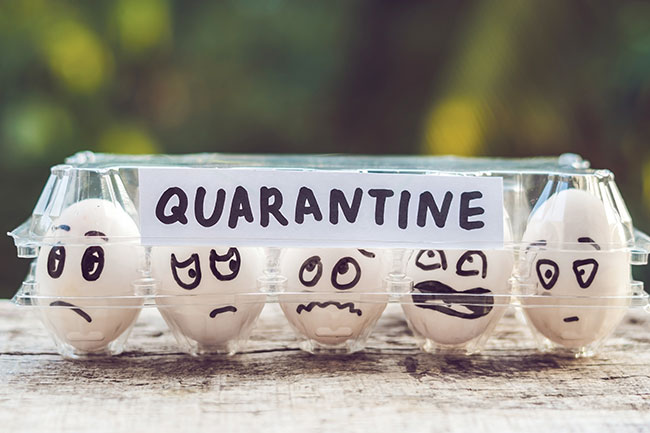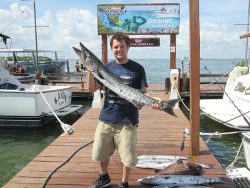
Biosecurity: critically important or just another dirty word?
February 18, 2022
By Mykolas Kamaitis
 The ultimate goal of biosecurity is to prevent potential pathogens from entering a facility or the environment in which a facility is located Photo: © galitskaya / Adobe Stock
The ultimate goal of biosecurity is to prevent potential pathogens from entering a facility or the environment in which a facility is located Photo: © galitskaya / Adobe Stock Fish farmers are familiar with the concept of biosecurity, and although it is embraced by many producers, it can still be a bit of a dirty word. Biosecurity may feel like an overly restrictive and exaggerated response to an invisible foe – all this fuss to minimize the risk of introducing a potential pathogen to your farm. Understandably, unless you have experienced a serious infectious disease outbreak, it may seem overblown or an unnecessary investment of time and resources, not to mention those annoying footbaths. However, all it takes is one or two significant outbreaks to demonstrate how critically important biosecurity can be to producing consistently healthy and productive fish. Understanding the principles of biosecurity is important but knowing how to apply it on your farm is what will ultimately make the difference.
Biosecurity refers to procedures and strategies used to prevent the introduction and spread of biological agents to, or between, a population of animals. In many ways, applying biosecurity principles is “common sense”, as long as you have an appreciation for how pathogens can be spread. Pathogens can spread directly between fish via the water, feces, excretions, and direct contact; they can also spread indirectly, entering the surrounding environment via the water, predators, other fish, excretions from other animals such as birds, equipment, personnel, and transport vehicles.
The ultimate goal of biosecurity is to prevent potential pathogens from entering a facility or the environment in which a facility is located. Although this is theoretically possible depending on the facility, it is nonetheless a challenge and one that may not be reasonably achieved. In a practical sense, we want to reduce the opportunities for pathogens to enter a farm.
The first step in developing a biosecurity plan is to conduct a thorough risk analysis of your farm. Go through your physical facility as well as the production flow and processes of your farm to identify where pathogens could enter your facility or spread between groups of fish. Biosecurity plans need to be catered to specific facilities; what works for one farm may be of little to no use at another. A risk analysis also allows producers to target their efforts, maximizing the bang for their buck. Biosecurity is about minimizing risk, and what is considered acceptable risk will depend in part on the producer, the facility, and the regulator, among other factors.
Once you have completed a risk analysis, critical control points can be identified and utilized to develop biosecurity protocols and standard operating procedures (SOPs). Establishing and implementing SOPs is vital to ensuring that adequate measures are in place and being upheld. It is important to develop useful SOPs by ensuring they are achievable and reasonable; staff need to be comfortable with the protocols and understand their value. If you need assistance with conducting risk analyses or SOP development, your veterinarian would be happy to help.
A good place to start implementing biosecurity protocols is the front door. Limit visitor access to your farm when possible and ensure visitors do not pose a significant risk – did the visitor just arrive from another fish farm? Were they recently in contact with sick fish? Did they swing by a river to cast a line on the way over to your farm? Establish a visitor log, including names, contact info, and a list of any other fish farms or places the visitors may have recently come into contact with fish. A visitor arriving directly from another farm does not necessarily constitute a hard “you cannot enter our facility” – it depends on the situation but it does carry risk with it. Putting up physical barriers such as fences, gates, and locking buildings can also help keep out unwanted visitors, both two-legged and four-legged.
The front door is also where disinfection plays an important role. Admittedly, it is difficult to know exactly how much benefit a two to three second dip of your boots in a footbath provides; however, it certainly has value in the biosecurity awareness that it instills in staff and visitors. Having site specific gear and equipment is a key element of biosecurity. It is also important to have gear and equipment that is specific to certain buildings, systems, and tanks. Should a pathogen enter your facility, this will help keep it contained, allowing for more effective management of any resulting issues. In cases when equipment needs to be shared between sites, thorough disinfection, including adequate drying time, is a must.
Another aspect of biosecurity is maximizing health and minimizing stress on your fish to limit their susceptibility to infection and disease. Considering the relative susceptibility of your livestock is also very important – in general, the youngest fish are most susceptible to disease. If you must travel to multiple farms in a day, or if you are in contact with different groups or year classes of fish at a facility, move from the youngest to oldest fish. When possible, having single year-class sites with an “all-in, all-out” production model is a powerful strategy to employ. Fallowing a site or system, along with thorough disinfection of fish rearing equipment is also valuable. Ensuring gametes are free of disease is another important step in maximizing biosecurity.
By no means was this an exhaustive list of on-farm strategies and applications of biosecurity, but it is a highlight of some important steps to ensuring you limit the introduction of pathogens to your farm. Speaking from experience, things always seem fine until they are not, and some biosecurity lessons come at a great cost. Best to learn from the mistakes of others and build a robust fish health management and biosecurity plan for your facility to prevent issues, rather than having to react to them.
 Dr Mykolas Kamaitis is a private practice aquaculture veterinarian and owner of Belwood Lake Veterinary Services in Ontario, Canada. He previously worked in the salmon industry in British Columbia as a vet and Fish Health Manager with Mowi Canada West. During his time at Mowi, Mykolas developed a strong background in production medicine and continues to take a preventative and production-focused approach to fish health management. He was named president of the Association of Aquaculture Veterinarians of British Columbia (AAVBC) in 2018 and continues in the role to this day.
Dr Mykolas Kamaitis is a private practice aquaculture veterinarian and owner of Belwood Lake Veterinary Services in Ontario, Canada. He previously worked in the salmon industry in British Columbia as a vet and Fish Health Manager with Mowi Canada West. During his time at Mowi, Mykolas developed a strong background in production medicine and continues to take a preventative and production-focused approach to fish health management. He was named president of the Association of Aquaculture Veterinarians of British Columbia (AAVBC) in 2018 and continues in the role to this day.





